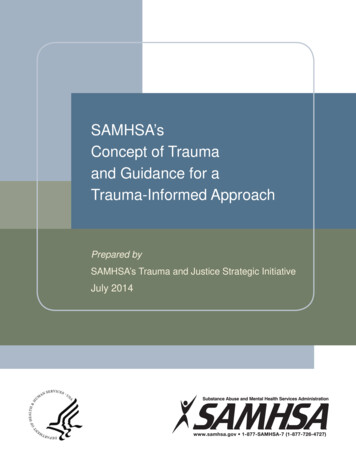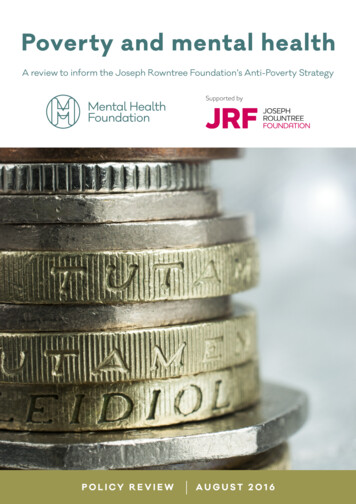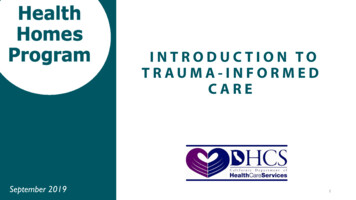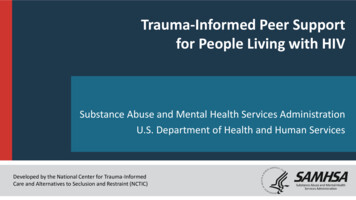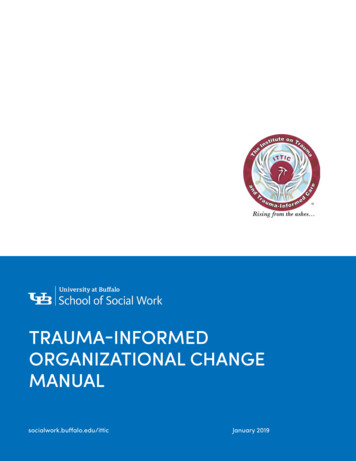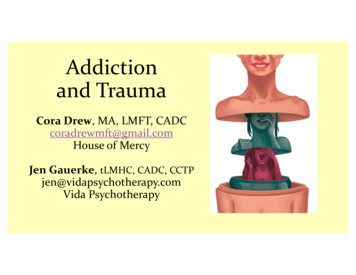
Transcription
SAMHSA’s Trauma-InformedApproach: Key Assumptionsand PrinciplesDRAFT TA Document
Section 1UnderstandingTraumaDRAFT
Learning ObjectivesSharedunderstandingDRAFTIdentificationof traumaSlide 4Awareness ofprevalence
Things to RememberVideo: Power of EmpathyDRAFTUnderlyingquestion “Whathappened toyou?”Symptoms Adaptationsto traumaticeventsHealinghappensInrelationshipsSlide 5
What is Trauma?Individual trauma results from an event,series of events, or set of circumstancesthat is experienced by an individual asphysically or emotionally harmful or lifethreatening and that has lasting adverseeffects on the individual’s functioningand mental, physical, social, emotional,or spiritual well-being.DRAFTSlide 6
The Three E’s in ause trauma.An individual’sexperience of the eventdetermines whether itis traumatic.Effects of traumainclude adversephysical, social,emotional, or spiritualconsequences.DRAFTSlide 7
Potential Traumatic tySexualAbandonmentRacismPhysicalNeglectDomestic violenceSeparationInvasive medicalprocedureWitnessing violenceNatural disasterCommunity traumaBullyingAccidentsHistorical ide 8Family member withsubstance use disorder
Experience of TraumaExperience of traumaaffected by:HowDRAFTWhenWhereSlide 9HowOften
Discussion QuestionHow can the same event betraumatic for one person andnot for another?DRAFTSlide 10
Effect of TraumaThe effect of traumaon an individual canbe conceptualized asa normal response toan abnormalsituation.DRAFTSlide 11
Effect, cont. Cause short and long-termeffectsTraumacan DRAFT Affect coping responses,relationships, ordevelopmental tasks Impact physiologicalresponses, well-being, socialrelationships, and/or spiritualbeliefsSlide 12
Signs of Trauma DRAFTSlide 13 Blowing up when being corrected Fighting when criticized or teased Resisting transitions or change Very protective of personal space Reckless or self-destructive behavior Frequently seeking attention Reverting to younger behaviors Nightmares or sleeping problems Sensitive to noise or to being touched Fear of being separated from family Difficulty trusting others Feeling very sad, angry, afraid; emotionalswings Unexplained medical problems Confusing what is safe and what isdangerous Trouble focusing or concentrating Difficulty imagining the future
Additional Signs of TraumaFlashbacks or frequentnightmaresSensitivity to noise or to beingtouchedAlways expecting somethingbad to happenNot remembering periods ofyour lifeFeeling emotionally numbLack of concentration; irritabilityExcessive watchfulness, anxiety,anger, shame or sadnessDRAFTSlide 14
How Trauma Affects the Brain Experiences Build BrainArchitecture Serve & Return InteractionShapes Brain Circuitry Toxic Stress DerailsHealthy DevelopmentDRAFTSlide 15
Brain DevelopmentDRAFTSlide 16
Abstract Thought Concrete ThoughtNeocortex LimbicDiencephalonBrainstemDRAFT AffiliationAttachmentSexual BehaviorEmotional ReactivityMotor regulationAffect regulationHunger/satietySleep Blood pressureBody temperatureHeart rateArousal states17Peers, TeachersCommunityFamily and FriendsCaregiverMother
Bottom Up Reactions to FearDRAFTSlide 18
Problems OR Adaptations?“Treatment resistant,uncooperative” t,combative” ORStruggling to regain orhold onto personalpowerFREEZE“Passive, unmotivated”ORGiving in to those inpowerFLIGHTSlide 19
Factors Increasing ImpactEarlyoccurrenceBeingsilenced ornotbelievedPerpetratoris trustedcaregiverBlaming orshamingDRAFTSlide 20
Adverse Childhood Experiences(ACEs) Affect Adult Health Adoption of health riskbehaviors as copingmechanisms (e.g., eatingACEs haveserious healthconsequencesfor adults:disorders, smoking, substance abuse,self-harm, sexual promiscuity) Severe medicalconditions (e.g., heart disease,pulmonary disease, liver disease, STDs,gynecologic cancer) Early death(FelittiDRAFTet al, 1998)Slide 21
The ACE Study“Male child with an ACE scoreof 6 has a 4600% increase inlikelihood of later becoming anIV drug user when compared toa male child with an ACE scoreof 0. Might heroin be used forthe relief of profound anguishdating back to childhoodexperiences? Might it be thebest coping device that anindividual can find?”(Felitti et al, 1998)DRAFTSlide 22
Trauma Prevalence in Children71%Number ofchildrenwho areexposed toviolenceeach year(Finklehor, et al,2013)DRAFT3millionNumber ofchildrenmaltreatedorneglectedeach year(Child WelfareInfo.Gateway, eirmothereach year(Child Witness toViolence Project,2013)Slide 231 in 4girls &1 in 6boysNumberwho aresexuallyabusedbeforeadulthood(NCTSN FactSheet, 2009)94%Percentageof children ina study ofjuvenilejusticesettings whohaveexperiencedtrauma(Rosenberg, et al,2014)
Prevalence (Children), cont.40-80% of school-age children experience bullying(Graham, 2013)75-93% of youth entering the juvenile justicesystem have experienced trauma(Justice Policy Institute, 2010)92% of youth in residential and 77% in nonresidential mental health treatment report multipletraumatic events(NCTSN, 2011)DRAFTSlide 24
Trauma in Adults: Mental Health50% of female &25% of maleclients84% Adult mental healthclients with historiesof traumaExperienced sexualassault in adulthood(Meuser et al, 2004)(Read et al, 2008)DRAFTSlide 25
Trauma in Adults: Mental Health, e 26 Earlier first admissions More frequent andlonger hospital stays More time in seclusionor restraint Greater likelihood ofself-injury or suicideattempt More medication use More severe symptoms(Read et al, 2005)
Trauma in Adults: Substance AbuseUp to 65% of all clients insubstance abuse treatmentreport childhood abuseUp to 75% of women insubstance abuse treatmentreport trauma histories(SAMHSA, 2013)(SAMHSA, 2009)DRAFTSlide 27
Trauma in Adults:Substance Abuse, cont.Over 92% of homelessmothers have severe traumahistories. They have twice therate of drug and alcoholdependence as those withoutAlmost 1/3 of all veteransseeking treatment for asubstance use disorder havePTSD(National Center for PTSD)(SAMHSA 2011)DRAFTSlide 28
Discussion QuestionWhat makes somethingtraumatic?DRAFTSlide 29
Section 2Principles ofTrauma-InformedApproachesDRAFT
Learning ObjectivesExplain whytrauma-informedprograms operatewith the universalexpectation thattrauma hasoccurredDRAFTExplain each ofSAMHSA’sprinciples andwhy it is importantGive positiveexamples of theimplementation ofeach principleSlide 31Name at least 3changes thatwould make yourown work settingmore traumainformed
DRAFTSlide 32
St. Aemilian-LakesideVideo about a trauma-informed program for children withemotional and behavioral problemsSt. Aemilian-Lakeside Trauma-Informed CareDRAFTSlide 33
The Four RsA trauma-informed program, organization, or system:RealizesRecognizesRespondsResistsDRAFT Realizes widespread impact of trauma andunderstands potential paths for recovery Recognizes signs and symptoms of trauma inclients, families, staff, and others involved with thesystem Responds by fully integrating knowledge abouttrauma into policies, procedures, and practices Seeks to actively Resist re-traumatization.Slide 34
SAMHSA’s PrinciplesSix principles that guide a trauma-informed change processDeveloped by national experts, including trauma survivorsGoal: Establish common language/frameworkValues-basedA way of beingDRAFTSlide 35
SAMHSA’s Six Key Principles of aTrauma-Informed Approach Safety Trustworthiness and Transparency Peer Support Collaboration and Mutuality Empowerment, Voice, and Choice Cultural, Historical, and Gender IssuesDRAFTSlide 36
Principle 1: SafetyThroughout theorganization, staff andthe people they serve,whether children oradults, feel physicallyand psychologicallysafe.Video: Leah HarrisDRAFTSlide 37
Who Defines Safety?For people who use services: “Safety” generally means maximizing controlover their own livesFor providers: “Safety” generally means maximizing controlover the service environment and minimizingriskDRAFTSlide 38
DiscussionDo staff feel safe inyour organization?Why or why not?Whatchangescould bemade toaddresssafetyconcerns?Do the peopleserved feel safe?How do you know?DRAFTSlide 39
Principle 2: Trustworthiness andTransparencyOrganizational operations and decisions areconducted with transparency and the goal ofbuilding and maintaining trust among clients,family members, staff, and others involved withthe organization.Video: Pat RisserDRAFTSlide 40
Examples of Trustworthiness Making sure people reallyunderstand their options Being authentic Directly addressing limits toconfidentialityDRAFTSlide 41
DiscussionHow can we promote trustthroughout the organization?Do the people served truststaff? How do you know?What changes could be madeto address trust concerns?DRAFTSlide 42
Principle 3: Peer SupportPeer support and mutual selfhelp are key vehicles forestablishing safety and hope,building trust, enhancingcollaboration, serving asmodels of recovery andhealing, and maximizing asense of empowerment.Video: Cicely SpencerDRAFTSlide 43
Examples of Peer SupportPeer support A flexible approach tobuilding mutual, healing relationshipsamong equals, based on core valuesand ide 44ReciprocalEmpathetic
DiscussionDoes yourorganization offeraccess to peersupport for thepeople who useyour services? If so,how?What barriers arethere toimplementing peersupport in yourorganization?Does yourorganization offerpeer support forstaff?DRAFTSlide 45
Principle 4: Collaboration andMutualityPartnering and leveling of powerdifferences between staff and clientsand among organizational staff fromdirect care to administrators;demonstrates that healing happens inrelationships, and in the meaningfulsharing of power and decision-making.Everyone has a role to play; one doesnot have to be a therapist to betherapeutic.Video: William KillebrewDRAFTSlide 46
Examples of Collaboration“There are no static roles of ‘helper’ and ‘helpee’—reciprocity isthe key to building natural community connections.”—SheryMeadHospital abolished special parking privileges and opened the“Doctor’s Only” lounge to othersModels of self-directed recovery where professionals facilitatebut do not directDirect care staff and residents in a forensic facility are involved inevery task force and committee and are recognized for theirvaluable inputDRAFTSlide 47
DiscussionCan you think of examplesfrom your agency of truepartnership between staff andpeople served?What about partnershipbetween top-leveladministrators and line staff?Can you think of changes thatwould significantly decreasethe power differentials in youragency?DRAFTSlide 48
Principle 5: Empowerment, Voice,and ChoiceIndividuals’ strengths and experiences arerecognized and built upon; the experience ofhaving a voice and choice is validated and newskills developed.The organization fosters a belief in resilience.Clients are supported in developing selfadvocacy skill and self-empowermentVideo: GAINS Center Interview VideoVideo: Mike SkinnerDRAFTSlide 49
ExamplesAsking at intake:“What do youbring to thecommunity?”DRAFTTreatmentactivitiesdesigned and ledby hospitalresidentsSlide 50Murals on wallspainted by staffand residentsTurning“problems” intostrengths
Discussion QuestionHow can you use yourclients’ strengths?DRAFTSlide 51
Discussion Can you think of examples from yourwork setting of empowerment, voiceand choice for people served? What about for staff? Can you think of policies orpractices that do the opposite—thattake voice, choice, and decisionmaking away? Could any of thesethings be changed?DRAFTSlide 52
Principle 6: Cultural, Historical, andGender IssuesThe organization activelymoves past culturalstereotypes and biases, offersgender-responsive services,leverages the healing value oftraditional culturalconnections, and recognizesand addresses historicaltrauma.Video: William KellibrewDRAFTSlide 53
Examples: A Place of HealingHawaii women’s prison builds a traumainformed culture based on the Hawaiianconcept of pu uhonua, a place ofrefuge, asylum, peace, and safety.Video: TEDx Talk by Warden Mark PattersonDRAFTSlide 54
Section 4SAMHSA’s Guidancefor ImplementationDRAFT
Learning ObjectivesDescribe why change isrequired at multiple levelsof an organizationDRAFTSlide 56Identify the organizationaldomains involved increating a traumainformed organization
Think of the six SAMHSA Principles as“goals,” and the 10 SAMHSA Domains asthe “interventions”—or ways you willachieve your goalsDRAFTSlide 57
SAMHSA’s 10 DomainsGovernanceand ssessmentand treatmentTraining andworkforcedevelopmentProgressmonitoring andqualityassuranceFinancingEvaluationSlide 58
Governance and Leadership1. How does agency leadership communicateits support and guidance for implementinga trauma-informed approach?2. How do the agency's mission statementand/or written policies and proceduresinclude a commitment to providing traumainformed services and supports?3. How do leadership and governancestructures demonstrate support for thevoice and participation of people usingservices who have trauma histories?DRAFTSlide 59
PolicyHow do writtenpolicies andprocedures:How do staffing policiesdemonstrate acommitment to stafftraining on providingservices / supports as partof staff orientation and inservice training that are:DRAFT Include a focus on trauma and issues ofsafety and confidentiality? Recognize the pervasiveness of trauma in thelives of people using services, and express acommitment to reducing re-traumatization andpromoting well-being and recovery? Culturally relevant? Trauma-informed?Slide 60
Policy, cont.How do human resources policies attend to theimpact of working with people who haveexperienced trauma?What policies and procedures are in place forincluding trauma survivors/people receivingservices and peer supports in meaningful andsignificant roles in agency planning, governance,policy-making, services, and evaluation?DRAFTSlide 61
Physical Environment of theOrganizationHow does thephysicalenvironment:Promote a senseof safety,calming, and deescalation forclients and staff?In what waysdo staffmembers:Recognize andaddress aspects ofthe physicalenvironment that maybe re-traumatizing?Work with peopleon developingstrategies to dealwith this?DRAFTSlide 62How has theagency:Provided space thatboth staff and peoplereceiving services canuse to practice selfcare?Developed mechanisms toaddress gender-relatedphysical and emotional safetyconcerns (e.g., genderspecific spaces and activities)
Physical Environment, cont.DRAFT63
DRAFT64
DRAFT65
DRAFT66
Healing Power of PetsDRAFTSlide 67
Engagement & InvolvementHow do people with lived experiencehave the opportunity to providefeedback to the organization on qualityimprovement processes for betterengagement and services?How do staff members keep people fully informed ofrules, procedures, activities, and schedules, whilebeing mindful that people who are frightened oroverwhelmed may have a difficulty processinginformation?DRAFTSlide 68
Engagement & Involvement, cont.How are transparency andtrust among staff and clientspromoted?What strategies are used toreduce the sense of powerdifferentials among staff andclients?How do staff members helppeople to identify strategiesthat contribute to feelingcomforted and empowered?DRAFTSlide 69
Cross-Sector CollaborationDRAFTIs there a system ofcommunication inplace with otherpartner agenciesworking with theindividual receivingservices for makingtrauma-informeddecisions?Are collaborativepartners traumainformed?What mechanismsare in place topromote crosssector training ontrauma andtrauma-informedapproaches?How does theorganization identifycommunityproviders andreferral agenciesthat haveexperiencedelivering evidencebased traumaservices?Slide 70
Children’s Resilience InitiativeDRAFTSlide 71
Screening, Assessment, andTreatment ServicesIs an individual’s own definition of emotionalsafety included in treatment plans?Is timely trauma-informed screening andassessment available and accessible toindividuals receiving services?Does the organization have the capacity toprovide trauma-specific treatment or refer toappropriate trauma-specific services?DRAFTSlide 72
Trauma-Specific InterventionsOften manualizedto ensure fidelityto an establishedmodelDesigned todirectly addressthe behavioralhealthconsequences oftraumaUsually deliveredby professionalstaff who havereceived extensivetraining in theprogram modelTraumaspecificinterventionsDRAFTSlide 73
Screening, Assessment, andTreatment Services, cont.How are peer supportsintegrated into the servicedelivery approach?How does the agency addressgender-based needs in thecontext of trauma screening,assessment, and treatment?For instance, are genderspecific trauma services andsupports available for bothmen and women?Do staff members talk withpeople about the range oftrauma reactions and work tominimize feelings of fear orshame and to increase selfunderstanding?How are these trauma-specificpractices incorporated intothe organization’s ongoingoperations?DRAFTSlide 74
Training and WorkforceDevelopmentHow does the agencyensure that all staffreceive basic training ontrauma, its impact, andstrategies for traumainformed approachesacross the agency andacross personnelfunctions?How does the agencyaddress emotional stressthat can arise whenworking with individualswho have had traumaticexperiences?How does the agencysupport training andworkforce developmentfor staff to understandand increase their traumaknowledge andinterventions?DRAFTSlide 75
Training and WorkforceDevelopment, cont.How does workforcedevelopment/staff training addressthe ways identity, culture,community, and oppression canaffect a person’s experience oftrauma, access to supports andresources, and opportunities forsafety?How does on-going workforcedevelopment/staff training providestaff supports in developing theknowledge and skills to worksensitively and effectively withtrauma survivors.DRAFTSlide 76
Training and WorkforceDevelopment, cont.What types of training andresources are provided to staffand supervisors onincorporating trauma-informedpractice and supervision in theirwork?What workforce developmentstrategies are in place to assiststaff in working with peersupports and recognizing thevalue of peer support as integralto the organization’s workforce?DRAFTSlide 77
Progress Monitoring and QualityAssuranceIs there a system in place that monitors theagency’s progress in being trauma-informed?Does the agency solicit feedback from both staffand individuals receiving services?What strategies and processes does the agencyuse to evaluate whether staff members feel safeand valued at the agency?DRAFTSlide 78
Progress Monitoring and QualityAssurance, cont.How does the agency incorporate attention toculture and trauma in agency operations and qualityimprovement processes?What mechanisms are in place for informationcollected to be incorporated into the agency'squality assurance processes?How well do those mechanisms address creatingaccessible, culturally relevant, trauma-informedservices and supports?DRAFTSlide 79
FinancingHow does the agency’s budget include funding support forongoing training on trauma and trauma-informed approachesfor leadership and staff development?What funding exists for cross-sector training on trauma andtrauma-informed approaches?What funding exists for peer specialists?How does the budget support provision of a safe physicalenvironment?DRAFTSlide 80
EvaluationHow does the agencyconduct a trauma-informedorganizational assessmentor have measures orindicators that show theirlevel of trauma-informedapproach?DRAFTHow does the perspective ofpeople who have experiencedtrauma inform the agencyperformance beyond consumersatisfaction survey?Slide 81
Evaluation, cont.What processes are inplace to solicit feedbackfrom people who useservices and ensureanonymity andconfidentiality?DRAFTWhat measures orindicators are used toassess the organization’sprogress in becomingtrauma-informed?Slide 82
Building Adult Capabilities to ImproveChild Outcomes: A Theory of ChangeVideo: Developing CapabilitiesDRAFTSlide 83
Section 5Healing andRecoveryDRAFT
Learning ObjectivesDescribe the effectsof trauma on thelives of those servedin the communityand across systems.DRAFTThink about what oursystem can dodifferently to enablehealing to take place.Slide 85Reflect on changesneeded to implementtrauma informedapproaches to focuson healing.
Behind Closed DoorsVideo: Behind Closed DoorsDRAFTSlide 86
SAMHSA’s Definition of RecoveryRecovery is a processof change throughwhich individualsimprove their healthand wellness, live aself-directed life, andstrive to reach theirfull potential.DRAFTSlide 87
What will you dodifferentlytomorrow, basedon what youlearned today?DRAFTSlide 88
Slide 7 . The focus on events places the cause of trauma in the environment not in some defect of the individual. This is what underlies\ഠthe basic credo of trauma-informed approaches: "It's not what's wrong with you, but what happened to you."\爀屲The focus on exper對ience highlights the fact that not every child or adult will experience the same events as traumatic.\爀屲The .




